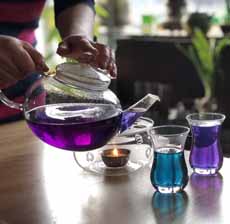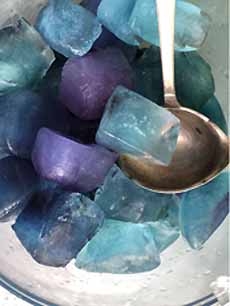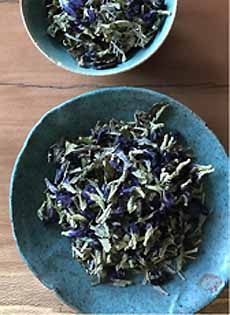TIP OF THE DAY: Blue Tea
|
Today’s tip comes via one of our favorite artisan tea blenders, Tay Tea. It’s blue tea, an herbal tea from Thailand that made its way here a few years ago. It still remains largely under the radar, except at artisan tea shops that blend their own teas. Butterfly pea flower tea is made by steeping the dried blue pea flowers in water. It can be served hot or iced (we vote for iced tea). The tea is naturally caffeine free and tastes floral, with a hint of earthiness. Adding lemon, lime or orange juice turns the brew purple. Both blue and purple colors are completely natural. You can use the same blue or purple tea to make stunning ice cubes for clear soft drinks or spirits. For July 4th festivities, serve blue iced tea with regular (white) ice cubes and garnish with red and blue berries. All-natural blue tea is produced using the flower of the butterfly pea plant also, commonly known as the blue pea plant. The bright blue flower is used as a natural coloring in many recipes. It’s one of the most vivid blue colors to exist in nature. The plant is native to tropical equatorial Asia, including India, Indonesia, Malaysia, Myanmar, Thailand and The Philippines. It is also known as Asian pigeonwings, bluebell vine, blue pea, butterfly pea, cordofan pea and Darwin pea [source]. The plant species belongs to the Fabaceae family, commonly known as the legume, pea, or bean family. The family includes such familiar foods as beans, carob, chickpeas, licorice, peanuts and peas. Now for the racy part: The botanical name of the butterfly pea plant is Clitoria ternatea. The botanist who named saw that the flower had the shape of female genitalia, and gave the genus the Latin name Clitoria, from clitoris (photo #5). You can see why others call it the butterfly pea plant. Tay Tea makes a blue tea blend called Azul (blue in Spanish), a fragrant, lemony blend of three botanicals: Packed with antioxidants and vitamin C, it’s good for you and keeps you colorfully hydrated. Here’s Tay Tea’s recipe: Ingredients For 5 Cups 1. BOIL five cups of water and add to a heatproof pitcher. Add two teaspoons of tea and let stand 10 minutes. 2. POUR the tea into glass and re-infuse tea leaves by pouring tea back into pitcher. Do this 4-5 times. Serve the bright blue tea hot, or let the tea cool and refrigerate. For purple tea… 3. ADD half a cup of lemon, lime or orange juice and watch the tea turn from bright blue to violet. Add a few wheels of citrus to the pitcher, and/or garnish glasses with individual wedges. 4. POUR over ice to serve. The tea plant, Camellia sinensis, originated in China. The word “tea” comes from there as well. While you may be familiar with the word cha, tea, in Mandarin, tea first arrived in Europe with the name “tay.” The Dutch traders who first brought tea to Europe in the early 1600s purchased it from tea traders in the port of Amoy (Xiamen) in the Fujian province. There are many dialects in China. In the Amoy dialect, tea was translated as te, pronounced tay, the pronunciation used by the Dutch. |
|
|
|
The French called it thé (pronounced tay), and it became te, pronounced tay, in Danish, Hungarian, Italian, Norwegian and Spanish. The “tee” pronunciation is found in English tea and German thee. In those countries where the tea trade was mainly via the caravan routes that traveled overland, from China to the west, it’s the Chinese Mandarin cha that is the common root: cha in Hindi, Japanese and Persian; ja in Tibetan, chai in Russian, chay in Turkish and shai in Arabic. Amoynese or Mandarin: Did your country’s tea first sail over the seas, or travel over land? Now you know!
|
||







